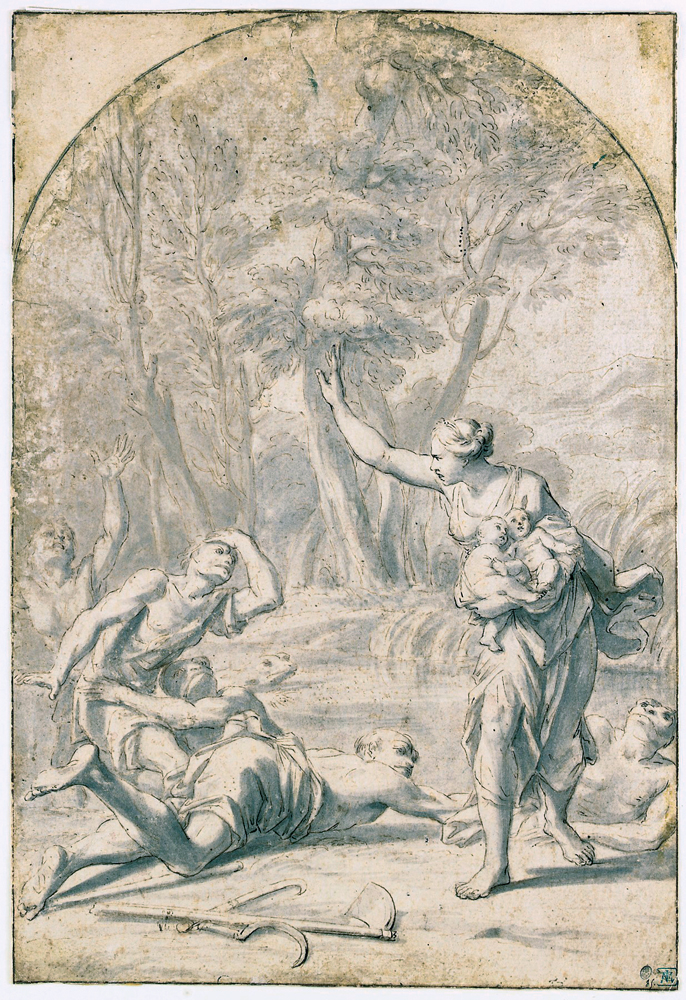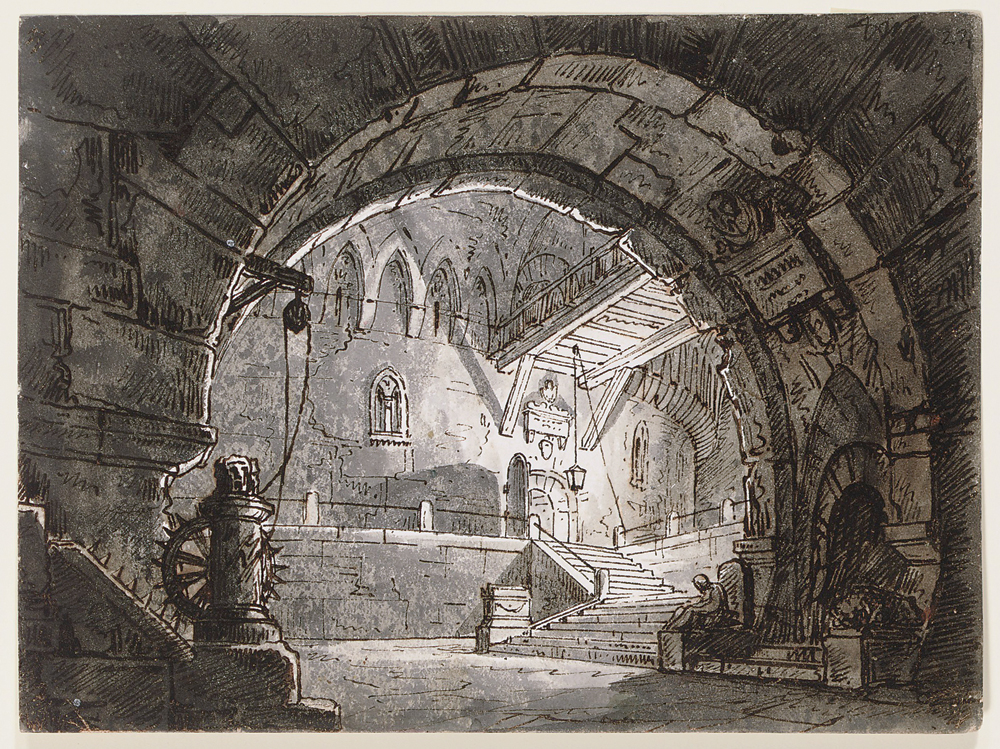Executed in a variety of mediums—pen and ink, graphite, chalk, crayon, ink wash—many drawings are preliminary studies for finished paintings or other works, including sculpture, architecture, decorative objects, and stage design. As such, they often convey the excitement of a work in progress, and this is even more palpable when the finished work is known and extant. Moreover, unlike an artist’s paintings, drawings are usually much more affordable, although big names still carry big price tags. It pays to scout the byways of the drawings market for more affordable treasures by lesser known artists.
That is exactly what one knowledgeable collector did. Julius Held (1905-2003), a revered art historian at Barnard College, was an authority on sixteenth- and seventeenth-century Dutch and Flemish art, and the author of important books on Rembrandt and Rubens. Collecting on a professor’s salary made him resourceful; he had to judge drawings on their artistic merits, relying on his aesthetic instincts and his vast knowledge to acquire satisfying works.
Let us look at two fine drawings from the Held collection that sold at Christie’s New York on January 27 and January 30, respectively. Both were priced with auction estimates well under $5,000 because their artists, though famous in their lifetimes, are not household names today: Latona Turning the Lycian Peasants into Frogs by the Bolognese painter Marcantonio Franceschini (Fig. 1), and a stage design reputedly for Vincenzo Bellini’s opera La Straniera attributed to the nineteenth-century Italian stage designer Alessandro Sanquirico (Fig. 2).

Franceschini
Franceschini was an extremely popular painter of large-scale decorative works, particularly frescos and altarpieces for palaces and churches in Bologna, Genoa, and Rome (including designs for some of the mosaics in Saint Peter’s). His patrons included Prince Johann Adam Andreas I (r.1684-1712) of Liechtenstein, for whose Gartenpalais in the Rossau area of Vienna he painted two large-scale cycles of the myths of Venus and of Diana between 1691 and 1709.
Franceschini’s painting of Latona, for which this lively drawing is a well-developed study, now resides in Vaduz Castle in Liechtenstein, having been shown in the Metropolitan Museum of Art’s exhibition Liechstenstein, the Princely Collection in 1985 and 1986. So there is a good, well-documented association value here. Franceschini took his theme from a Greco-Roman myth found in Ovid’s Metamorphoses: Having borne the twins Apollo and Diana fathered by Jupiter, king of the gods, the goddess Latona is being pursued by Jupiter’s vengeful queen, Juno. Fleeing through Lycia and desperately thirsty, Latona encounters a pond where workers are gathering reeds. The workers refuse to let her drink, and when she persists, they jump into the pond to foul it. Thus goaded, Latona declares, “live in that pool of yours forevermore,” and, waving her arm, transforms the louts into frogs.
Measuring 14 7⁄8 by 10 inches, and estimated at $4,000 to $6,000, the drawing captures this moment with expressive postures and subtle humor. Cradling her babies while striding for ward, Latona casts her spell with a sweeping, theatrical gesture. In the middle of the pond, one peasant is already completely transformed, while the others gesticulate frantically as their muscular bodies contort with amphibious change, their mouths grotesquely widen, and their eyes bulge.
Franceschini’s relatively sketchy pen-and-ink lines reinforce the linear contours of his figures, but he achieves a high degree of finish by using subtle ink wash to shade and solidify the drawing. He makes the background landscape recede naturally by using fewer, lighter pen strokes with greater reliance on wash, thereby providing an inviting sense of depth to the overall scene without sacrificing linear definition.
Two pairs of Franceschini’s paintings fetched hammer prices of $486,400 and $360,000 at Sotheby’s New York in January 2006 and January 2007, respectively. On January 27 this drawing fetched $10,000 which suggests that it was attractive enough to get two competitors to wage a bidding war.

Sanquirico
The study for a stage design attributed to Alessandro Sanquirico, measuring 7 1⁄2 by 9 1⁄8 inches, was estimated at $800 to $1,200. The finished work would have been executed on life-size canvas flats, probably by the artist with one or more assistants. Christie’s sale catalogue notes that an Italian inscription on the back of the drawing specifically connects it with Bellini’s La Straniera. La Straniera, with Sanquirico’s sets, premiered at La Scala, Milan, in February 1829; however, checking the librettist’s detailed descriptions of the first production, I found no setting that actually corresponds to this dark image.
Nevertheless, even if the inscription is spurious or represents an earlier stage of the design process, this drawing, which Held originally purchased with an attribution to a different stage designer, captures the fundamental aspects of nineteenth-century romantic theater. Though there are traces of black chalk, the artist worked mainly in pen and brown ink, using gray wash to achieve dramatic tonal effects of light and shadow in a deliberately haunting architectural setting. The setting itself reflects the strong inspiration of the Gothic revival movement. Moreover, Sanquirico’s chiaroscuro effects, the low perspective, the arch, stairs, and overhead gangway are obviously influenced by the famous series of imaginary prison designs etched by Giovanni Battista Piranesi (1720-1778) in 1749 to 1750, which remain among that artist’s most sought after works today.
In November 2008 three sets of Sanquirico stage designs, sketchier and less dramatic than this one, failed to sell at auction at Porro and C., Milan. All three were estimated at €800 to €1,000 ($1,006-$1,258).
Even with its vagaries of attribution, the drawing stands on its own merits, and obviously others agreed, because it sold for $2,000 including premium. And that’s still eminently accessible.
Tips
❖ Many museums such as the Metropolitan Museum of Art and the British Museum have far more drawings archived than on their walls, and are often willing to allow access to these by appointment.
❖ To familiarize yourself with the inspiration for artists from the Middle Ages through the early twentieth century, it is useful to have a personal reference library including a Bible, a good Bible dictionary, a copy of Thomas Bulfinch’s Mythology (superseded, perhaps by modern classical scholarship, but still the most engagingly readable source), and other classic references such as George Ferguson’s Signs and Symbols in Christian Art and James Hall’s Dictionary of Subjects and Symbols in Art.
❖ Learn how the mediums of drawings look-chalk and crayon against a highly toothy (textured) laid paper look very different from ink, or graphite, metalpoint, wash, watercolor, tempera or gouache.
❖ Drawings have traditionally been made on a variety of hand- and machine-made papers, paperboard, and other supports, often prepared witha ground. Familiarize yourself with materials and terms-laid paper, wove paper, rice paper, and the like-and know which materials are appropriate to which periods. An authentic eighteenth-century French drawing will never appear on the kind of brittle wood-fiber paper used in 1920, but a printed or hand-drawn copy might. It also pays to be aware of watermarks, which can be used to date papers.
❖ A good academic course on drawing can give you matchless experience with the materials and the skills to train your eye.
